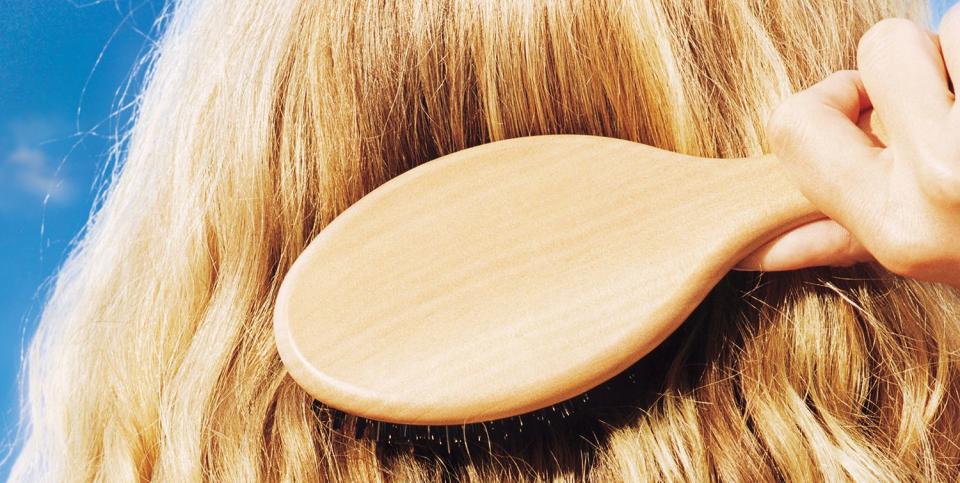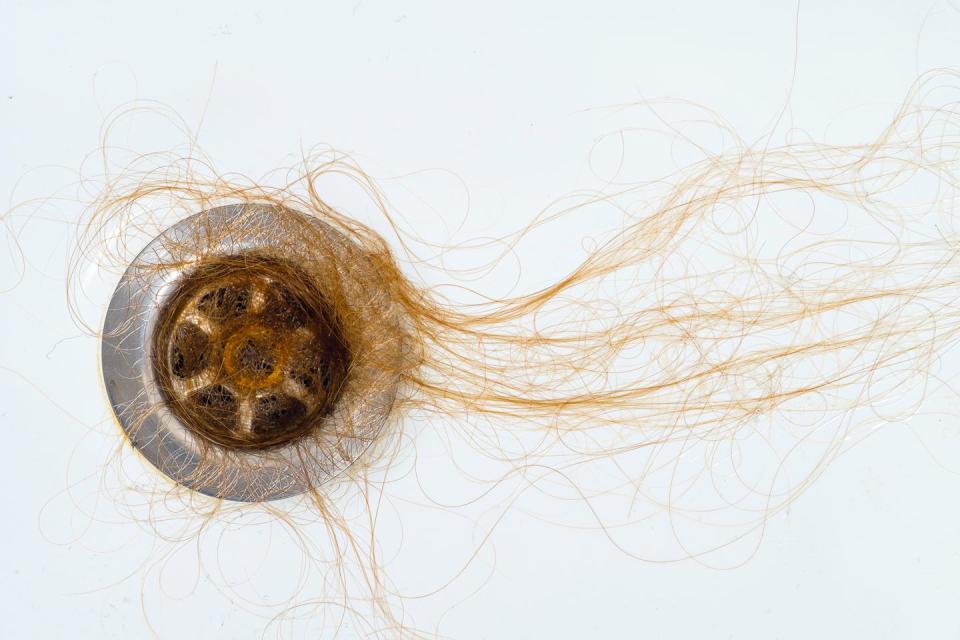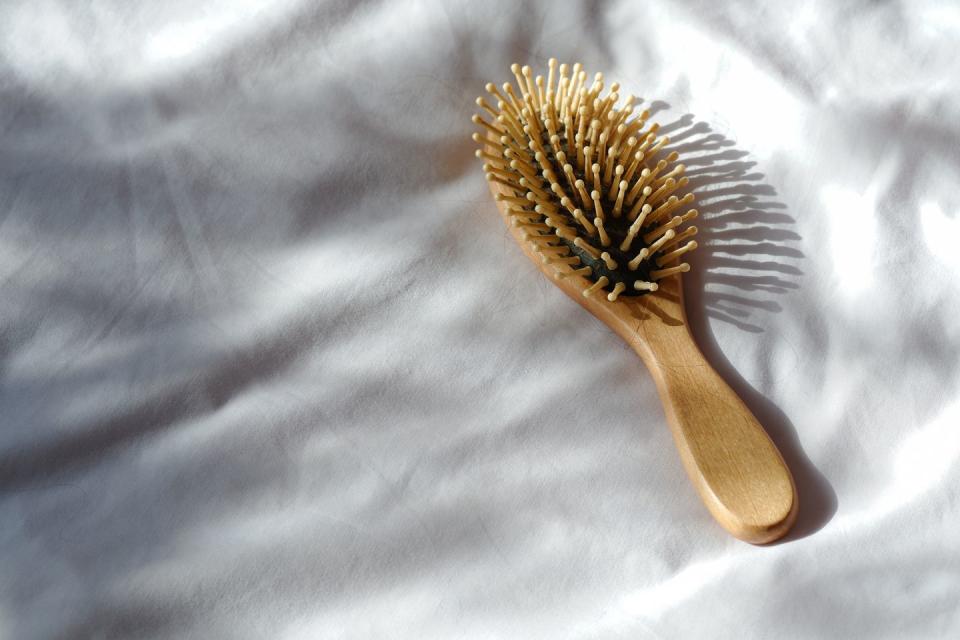Postpartum Hair Loss - How To Manage The Unruly Regrowth And More

In the final weeks of pregnancy, those apps that tell you the size of your baby in fruit and veg terms will be firmly at the watermelon stage. Accordingly, most people appreciate that their bodies are going to look a little different post-baby than they did pre. But the change we’re not always so well prepared for? What’s about to happen to our hair. We're talking about postpartum hair loss.
The cruel thing is that your hair probably never looked better than during pregnancy. 'Oestrogen levels rise, which keeps hairs in the anagen (growth) phase of the hair growth cycle for longer than usual. Fewer hairs are shed, and by the end of pregnancy, hair often feels thicker and more voluminous,' explains Anabel Kingsley, trichologist at Philip Kingsley.
However, once the baby is born, oestrogen levels return to normal, and your pregnancy hair glory days come to an abrupt end. In Kingsley’s words, 'hairs that were kept in the growth phase move all at once into the telogen (shedding) phase of the growth cycle, creating substantial hair fall.'

The loss is, of course, different for everyone. Some people barely notice the additional hair fall, whilst others experience thinning and even bald patches. Naturally, the loss can be exacerbated by other factors - think poor diet, stress - which are, as Kingsley points out, 'more likely with the responsibility of looking after a baby.' For most of us though, postpartum hair shedding is a (mercifully) temporary phase which we can’t actually do anything to prevent. (For more extreme loss, which can be very distressing, Kingsley recommends asking your doctor to check for nutritional deficiencies and thyroid levels, or visiting the Philip Kingsley Trichological Clinic in Mayfair for a consultation.)
After the birth of my own child, I counted myself pretty lucky in hair loss terms. Sure, an elastic now needed to be wrapped three times around my ponytail instead of two, and perhaps the hair around my hairline was a little patchier, but essentially I still had quite a lot of hair and I doubt many people noticed aside from me. I didn’t love it, but I made my peace with it, aided by having no time to look in the mirror.
What I wasn’t ready for was the regrowth phase. The hair I thought I’d lost relatively subtly grew back in a way that was decidedly unsubtle. The word that comes to mind is 'tufty' - spiky, inch-long wisps of hair that sprung up around my temples, parting and crown, managing to work their way through my longer hair to create a constant halo of frizz. Much coarser than my usual hair, they didn’t respond to brushing, blow-drying or my constant attempts at flattening. These babies, they do a real number on your physical appearance.
'It’s a dreadful phase, those tufty baby hairs are unruly,' sympathises Fiona Toomey, founder of skincare, haircare and wellness brand, Nessa, and mother of three. 'We originally started Nessa two years ago as a postpartum brand, and hair loss was probably the second or third most common issue amongst our customers. Personally, I noticed a massive change in my hair - not only hair loss, but the texture completely changed.'
Nessa’s Crowning Glory Scalp and Hair Oil takes a two-pronged approach to dealing with postpartum hair. 'Firstly, when used directly on the scalp as a massage oil, the soothing and exfoliating properties encourage a healthy scalp primed for regrowth,' Toomey explains. 'Secondly, we know one of the biggest issues is the regrowth phase and those pesky baby hairs. This new formula is so light that you can slick down those baby hairs when your hair is wet or dry, while also giving them a conditioning treatment.'
Kingsley is another to advocate scalp care - Philip Kingsley’s Stimulating Daily Scalp Toner is brilliant - but also highlights the importance of what goes into your body for providing hair with the internal support it needs to grow.
'Try to eat a healthy, balanced diet rich in protein, complex carbohydrates and iron. As it can be very difficult to eat well when you are looking after a newborn - plus your body may well be depleted and have extra requirements due to breastfeeding - supplements can be very handy here,' she says. She recommends a daily protein supplement such as Philip Kingsley PK4 Soya Protein Boost as well as a multivitamin containing iron, vitamin C, L-lysine, vitamin B12 and vitamin D.
But what about styling, whilst you’re waiting for those inch-long tufts to grow out? Celebrity hairdresser George Northwood has seen plenty of postpartum hair loss and regrowth at his Fitzrovia salon over the years, and has developed a series of foolproof hacks.
'The best thing is to get a Mason Pearson brush or even a toothbrush, spray a decent, strong hairspray onto it, and brush then hairs right down. I do it on shoots a lot, it really works,' he assures me. 'I use it on people who are prone to flyaways generally, it just creates a smoother surface. You could also use something like the George Northwood Undone Moisturising Cream - not too much, but just running it through to act as a sort of glue to keep the hair together. That’s especially good if you’re wearing your hair up.'
Your cut can make a difference too. You can move your parting around to conceal particularly thin areas, or if you have longer hair, Northwood suggests lopping off a good few inches to create the illusion of fullness and bounce. 'Consider leaving it one length and focus on making the ends look thick and chunky,' he says. 'As it gets longer you could do a bit of layering around the face, but that’s more for when those baby hairs are closer to fringe length. It is a bit of a waiting game unfortunately.'

At the end of the day though, with your baby (hopefully) in bed and a glass of wine finally in hand, try not to worry. It’s temporary, there are workarounds, and you won’t have to look further than your local baby group to find ten other mothers going through the exact same thing. Also, it’s a marker that your body has done something pretty amazing.
'With some clients that have had several babies, I can literally see the effect of each one on their hair. Like three different lengths for three different babies,' Northwood says. In the end, your hair tells the story of your family growing - and if that’s not a pretty good way to try and reframe hair loss, then I don’t know what is.
You Might Also Like

 Yahoo Finance
Yahoo Finance 